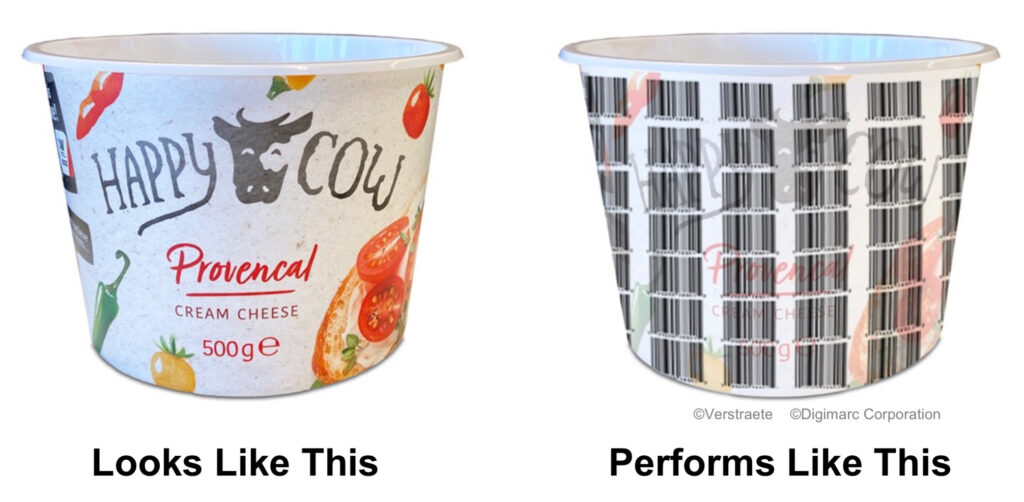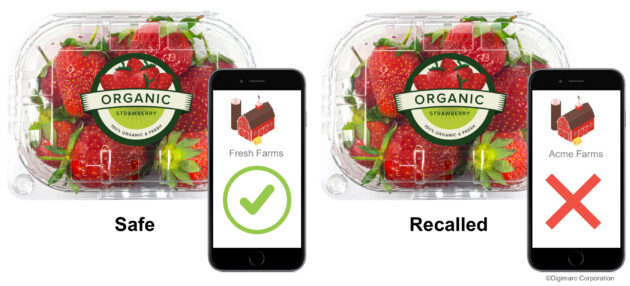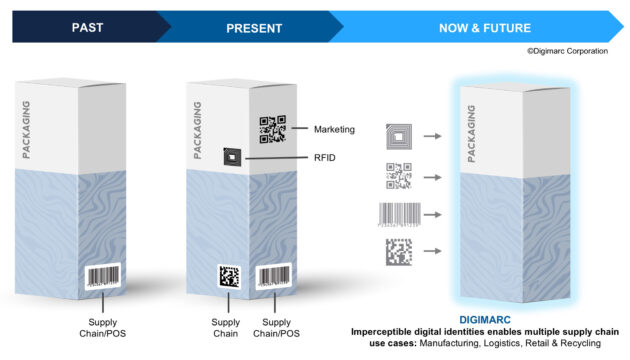
Features
Digital Printing
Printing
Labels as storytellers
Technology is optimizing labels for better brand engagement and product management
September 9, 2022 By Treena Hein
 How Digimarc digital watermarks perform on printed labels. Photo courtesy Digimarc
How Digimarc digital watermarks perform on printed labels. Photo courtesy Digimarc In this day and age, new ways to engage with old and potential customers have never been more critical. To catch the attention of the public, especially the younger generation, innovation is ramping up in area of ‘smart label’ technologies.
“At a time when the e-commerce channel continues to grow, the ability for brands to connect directly with consumers through digitized products is invaluable,” explains Phil Stafford, director of global channels at Digimarc Corporation. Connecting directly means that consumers not only interact with the real product physically, but also with its digital twin (a version of the product accessible solely through internet-enabled technologies).
These innovations provide consumers with dynamic and more rewarding experiences with a product, even personalized experiences that might enrich their lives in a meaningful way. Stafford explains that as consumers become more familiar and comfortable with digitized products, they’re more willing to engage with them, “especially when the content is of value.”
For companies, the benefits of smart labels are obvious. When a new form of digitized product hits the market, it gets a lot of attention. The brand also becomes associated with the use of new, cutting-edge technologies, making these products seem ‘cool.’
However, there are other benefits in the direct communication channels created by smart labels between companies and their customers, says Stafford. Brands receive valuable, consensual data from consumers of the product in real-time, such as when, where, and how often a product is being interacted with, even when and where consumption occurs. This direct data capture informs future marketing strategies, allows companies to identify purchasing and consumption trends, and so on.
A look back
It’s been common for a few years now for companies to print QR codes on their labels to provide consumers with a direct link to product information. This might be the date on where and how the product was made, or even traceability of ingredients.
Companies like Multi-Color Corporation (MCC) offer a variety of interactive ‘smart label’ options that include reaction to heat or cold. Another example came on the Brazil market in June 2022, when limited-edition bottles of Sol beer were released sporting labels with photochromic (light-activated) ink developed by MCC. When exposed to sunlight, the label reveals a hidden message to consumers, enhancing their experience with the brand and reinforcing a connection with the brand name and the power of the sun.
Another example is the personal ‘Reel Label’ used by British Columbia-based Jones Soda. These labels have images of real customers on them, and other customers can learn the story behind the moment captured in the label through Augmented Reality (AR) videos on the Jones Soda app.
“We see customers utilizing these for promotional products and high-engagement campaigns,” says Kimberly Flynn, marketing project manager at MCC. “For AR and virtual reality, we have a number of customers who have launched very successful campaigns where consumers hold up their smart phones and the label comes to life. We haven’t seen these platforms grow at the same level as some of the other smart packaging options, but the brands that have introduced this technology have been quite successful.”
This has certainly been the case for Australia-based Treasury Wine Estates. In 2017, it became the first wine company in the world to use an AR platform across its portfolio. For example, through a company app available in over 90 countries, consumers hover their smartphone over the label of the firm’s ‘19 Crimes’ bottles and are introduced to the associated real historical criminals. This innovation helped in achieving double-digit growth of the 19 Crimes brand in the US, and netted Treasure Wine Estates a prestigious Super Reggie marketing award.
Now, AR ‘smart labels’ have become truly interactive. The first Internet of Things packaging platform, recently developed by MCC and a company called Talkin’ Things, combines AR with near field communication (NFC) technology on the labels for an imaginary brand called ‘Black Beer.’
As explained by MCC, when the Black Beer smart label is scanned (again, using an app), “the skull displayed on the label engages in interactive dialogue with the consumer. The facial recognition feature detects if the customer is happy or sad and customizes the next part of the dialogue. Variable AR scenarios are also launched, depending on answers provided to questions asked by the skull.” The product also recognizes when the product has been opened, which changes the responses of the skull.
Operation and supply chain benefits
Other smart packaging and smart labelling applications, notes Flynn, are more operational, such as RFID and electronic article surveillance (EAS) tag inlays for product tracking and inventory management.
“The increase in online shopping has expedited the use of passive tags to manage operations and product tracing,” she says. “We see a larger growth in this segment of the market. Retailers are developing policies that consumer packaged goods brands are answering with tags applied either onto the container or onto the label before the container.”
For product security, among its other technologies MCC offers secure QR codes, a new kind of QR code containing public and private data. Consumers scan the tag to instantly receive a message confirming the authenticity of their purchased item. The public data can be read by any reader such as a smart phone. The private data is encrypted and protected with a password that can only be unlocked with a proprietary scanner. The technology provides product tracking, traceability, and anti-counterfeiting applications.
Digimarc currently offers digital watermarks, which are created by subtly modulating the pixels in the label artwork design at a very low level, so that there is no perceptible structure to it such as what’s seen with an EAN or QR code.
They came about seven years ago, when Digimarc started exploring the use of watermarks for consumer-facing packaging and labels, which would carry the same Global Trade Item Number as a UPC/EAN code and be scanned by a retailer ‘point of sale’ device. They are being used in North America for brand protection purposes, parts matching, supply chain improvements and front of store efficiency.
Digital watermarks were created by Digimarc founder, Geoff Rhoads, who is also an astronomer. “The concept arose from his work removing noise from digital photos of deep space imaging,” says Stafford. “The science behind watermarking is quite amazing and by using proprietary Digimarc software, any printed image can have an imperceptible watermark embedded into it, and yet, be easily scanned by a mobile phone app or device that uses our decoding software.”
Digimarc can also combine digital watermarks with QR codes, or RFID or NFC tags. “Using dual-factor authentication, brands now have the strongest defense possible in the fight against counterfeiters,” says Stafford. “This product is supported by our product cloud that allows brands to track every product item through the supply chain, customs inspection and on-shelf via brand inspection agents.”
Improving recycling
Digimarc’s digital watermarks are also durable (i.e. able to be scanned in difficult environments). This means they can be used to collect information about package recycling.
When the watermarks are scanned at a recycling depot, the system can access unlimited information, including characteristics of the packaging such as type of plastic or the presence of components that are problematic for recycling. Digimarc has recently partnered with Canadian company Winpak to test this, as part of the Circular Plastic Taskforce initiative.
“This technology can better help material recovery facilities understand what materials are coming in and how better separate them to make ‘cleaner’ bales,” explains Winpak Director of Corporate Sustainability Phillip Crowder. “The information gathered can also help a brand to understand how much of the packaging is being recycled, and how they can perhaps improve that rate.”
Crowder adds that on the consumer side, these watermarks can also communicate to consumers the environmental attributes of packaging and where to best recycle it, let alone all kinds of information to the consumer about the product itself such as nutritional information and meal preparation ideas.
With more and more innovations like this, it seems smart labels, and the companies that use them, are getting smarter all the time.
An edited version of this article originally appeared in the July/August 2022 issue of PrintAction.
Print this page

